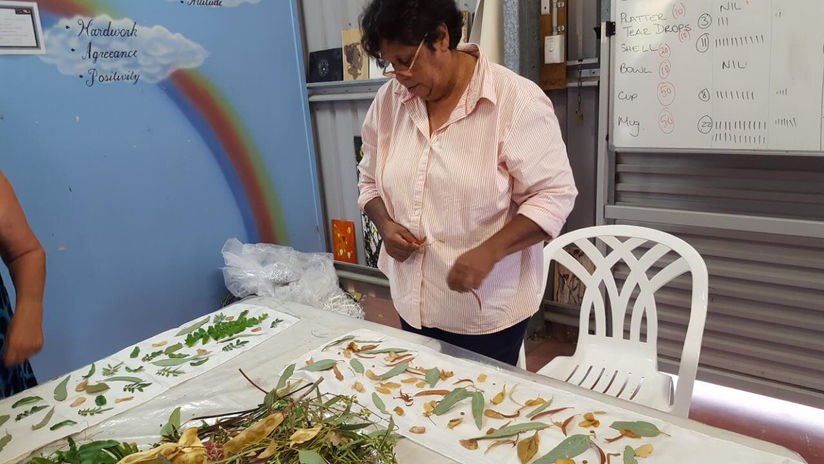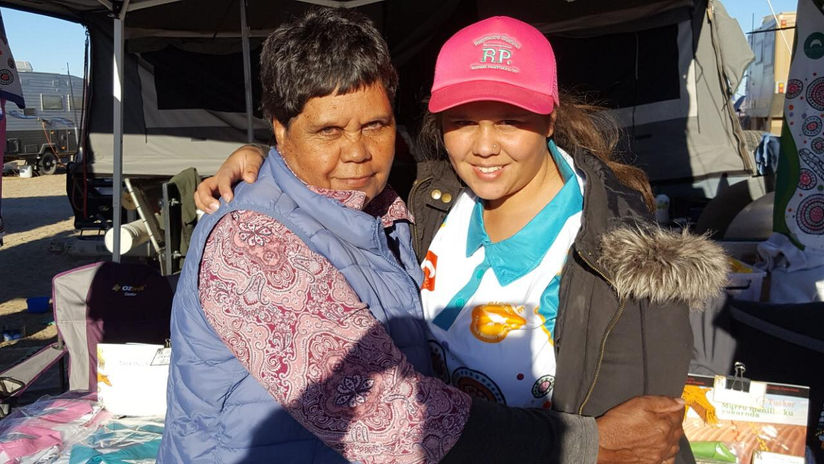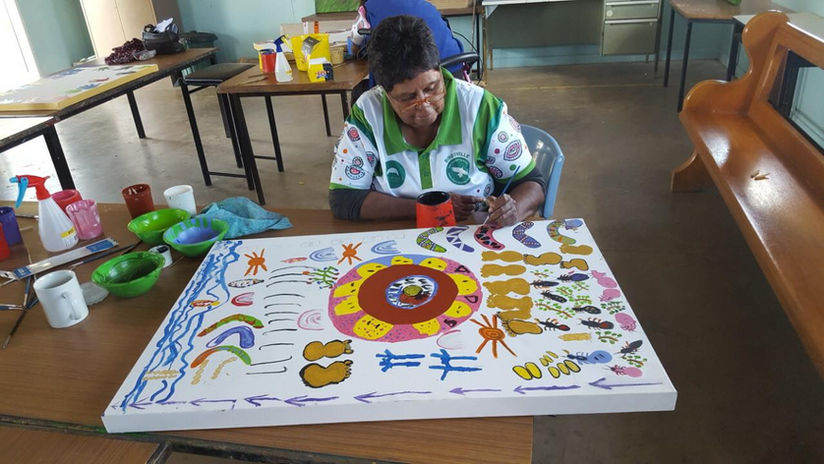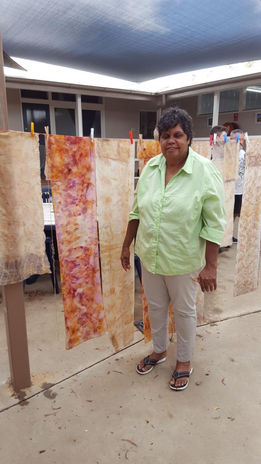ARTIST PROFILE

Aulpunda Jean Barr-Crombie
Traditional Aboriginal and Cultural Artist
Jean's art tracks her journey through country as she weaves the old stories with colours of the land in a unique spirit of discovery. She finds beauty in the gnarled tree, and love in the sand against bare feet, a love for country that brings colour and life to her paintings.
For Aulpunda (Jean), a Wangkangurru /Yarluyandi woman, the big questions inspire her work are, 'who am I, and where do I belong?' These are the questions she explores in her artistic journey.
Through deep listening to the spirit of the land, a spirit that beats in her blood, Jean comes to her art as learner and teacher, bearing the gifts of an ancient culture to share with family, children, grandchildren, and those not yet born.
Two Sisters Talking
Sisters, collaborators, and lifelong friends; Anpanuwa Joyce Crombie and Aulpunda Jean Barr Crombie form a duo that weaves their culture and traditions into the amazing art they create. Growing up in the Wangkangurru/Yarluyandi country of Birdsville in our remote Western Queensland region, both sisters have a deep understanding and connection to their land they love. From the rich burnt orange of our soil to the vibrant greens we see after a good rain, Joyce and Jean capture the very essence of what their country means to them within their traditional Aboriginal artwork.
But more than expressing their love for Country they live upon, Joyce and Jean’s art and literature aim to share the culture, language, and stories they were taught when they were young. Forming a duo called ‘Two Sisters Talking’, Joyce and Jean have made it their mission to document their culture in books, art, and audio before it becomes lost to time.
‘The first book we wrote together was the ABC Children’s Talking book, and we wanted to get it out there because we felt there was no one else that could spread our culture and carry on,’ explains Joyce. ‘Our late Father’s and Mother’s passion to share culture has motivated us to continue in their footsteps. So, to start things off, we started with the alphabet of our Wangkangurru language, with animals to match, and we did our own artwork for the books. We felt it was really important because we wanted to hand all of the knowledge we had down to our younger generation— Mum and Dad handed it to us when we were young, and it was our turn to do the same.’
As time marches ever forward, the rapid loss of culture and tradition shared amongst our Aboriginal communities has meant, for some, a loss of connection with their heritage and country. Having grown up in a time where culture was fading around them, Joyce and Jean feel it is paramount they share their knowledge so that the younger generation can experience the full richness of their heritage, too.
‘Walking and Talking Together—we want to share as much as we can so other Wangkangurru / Yarluyandi people can understand the country they came from, and the traditions that make us who we are. For us, there is nothing more important than teaching what we know,’ explained Jean. ‘we just want to share our culture and not let go of it.’
‘We were lucky because Mum, Dad, and our family Elders knew our language, which has been recorded and kept in a safe place up until we started our language books. When we were younger, we didn’t listen as much as we should have. Now that we’re older and wanting to pass it onwards, we are creating our books, and what we want to do in the future is make a dictionary for our language. What we hope is that others can stand up and share their stories too, before it's lost.’
Having published the ABC Children’s Talking book and a recollection of their childhood through the book Looking For Tucker, Joyce and Jean’s efforts to document their language has not only created resources that will last into the coming future, but have also created an inspiring set of beautiful stories and artworks that fully capture what it means to be a part of a culture, a way of life from a completely new perspective.

Our heritage, Our culture, Our voice
Culture; the story of a people through one voice, one song. With the traditions that we love, and the tales we cherish, we are able to form our identities as a collective by sharing and celebrating this mutual adoration for our heritage. Without this fundamental part of our culture, our identities and the way we bond together would be lost to time.
One such artist who treasures her culture in a time when much of it has been lost is Aulpunda Jean Crombie. With a deep love for the Wangkangurru/Yarluyandi country she grew up in, Jean’s main focus is bringing to life not only the land through her paintings, but the story within it.
‘I just love painting the country,’ explained Jean. ‘It’s very colourful, and it really comes out in the dot paintings. I just have a love for painting, and the country, so when I bring them together, it surprises me what I can do. Artwork tells its own story—especially when there’s a language involved. We don’t want to lose that connection; we are talking about our culture when we paint, so its really important we do share and connect with other people so it’s not lost. The most important thing is passing those skills on to our younger generation.’
Through her love of country, Jean also aims to share the beauty often overlooked—the hidden views and the soaring landscapes that make the Outback a place of mystique and wonder.
‘I like sharing what’s out there with people don’t usually see it. The beauty of the country, even in drought, it’s really got a beautiful look to it. The green is so vibrant when we got good rain, and the reds and greys are too when we don’t. Its amazing to see the drastic differences, and to put it on canvas.’
Growing up in the center of our Queensland Outback, however, Jean didn’t always dream of being an artist—in fact, art hadn’t been in her game plan at all. Encouraged by her sister, Anpanuwa Joyce Crombie, Jean at first resisted the call to paint.
‘When I first started, it was hard to even think that I could do paintings. All I could think about was the mistakes—how could I get rid of it? What if I make something ugly? Just silly little thoughts like that that held me back. But when you actually start to do an artwork, it sort of just falls into place,’ explains Jean.
‘The first painting I did was of our Dreamtime swan— from that, I just kept on painting. I think I really enjoyed expressing the connection to our country, like with our swan and our Dreamtime snake, in my paintings. Really, every painting tells a story. It is really easy when you know what story you want to tell, but when you first start its scary.’
Now, with years of artistic experience under her belt, Jean has published several Aboriginal picture books with her sister Jean, featuring their artwork. With the love of country and culture behind the pair, called ‘Two Sisters Talking’, Jean hopes that her art now inspires others to engage with their own cultures too.
‘Knowledge is what I’m trying to share with others through my art. The younger generation is a big motivation too—I share my work so that they can learn their stories, their culture, their connection and be a part of it. They can say where they came from, that this was the story they were told when they were younger, that this is my language. That’s what I want to see happen for the younger generation, and I hope my art is a step towards that future.’








